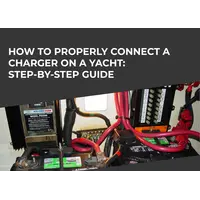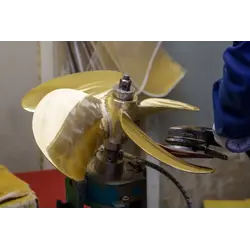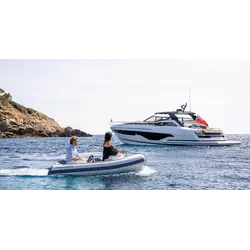PVC dinghy maintenance over time
Unlike inflatable boats made of rubberized fabric, which can mold and rot, PVC dinghies are much more durable and immune to moisture in warm and tight storage space, which literally kills rubber boats.
This is achieved by using more modern materials in the manufacturing process with the main role given to polyvinyl chloride, polyurethane and hypalon. But even such seemingly eternal boats have weaknesses that cannot withstand the hardships of an aggressive external environment and errors during operation and maintenance.
How to protect a PVC boat from negative external influences
Before setting out the methods for protecting the boat in the conditions of regular usage, it is necessary to determine what negative influences can lead to the destruction of such a durable material as polyvinyl chloride.
The problems are primarily: mechanical damage from hitting sharp stones, the boat hitting a rocky shallow at high speed, as well as collisions with floating logs and sunken snags. Sometimes the cause of damage to the boat is driftwood stuck in the bottom surface in a vertical position. It happens that on some firewood in the water there are sharp shells or nails left in the wood. The bottom of the boat also wears out quickly if the ship is constantly dragged to the water along the rocky shore.
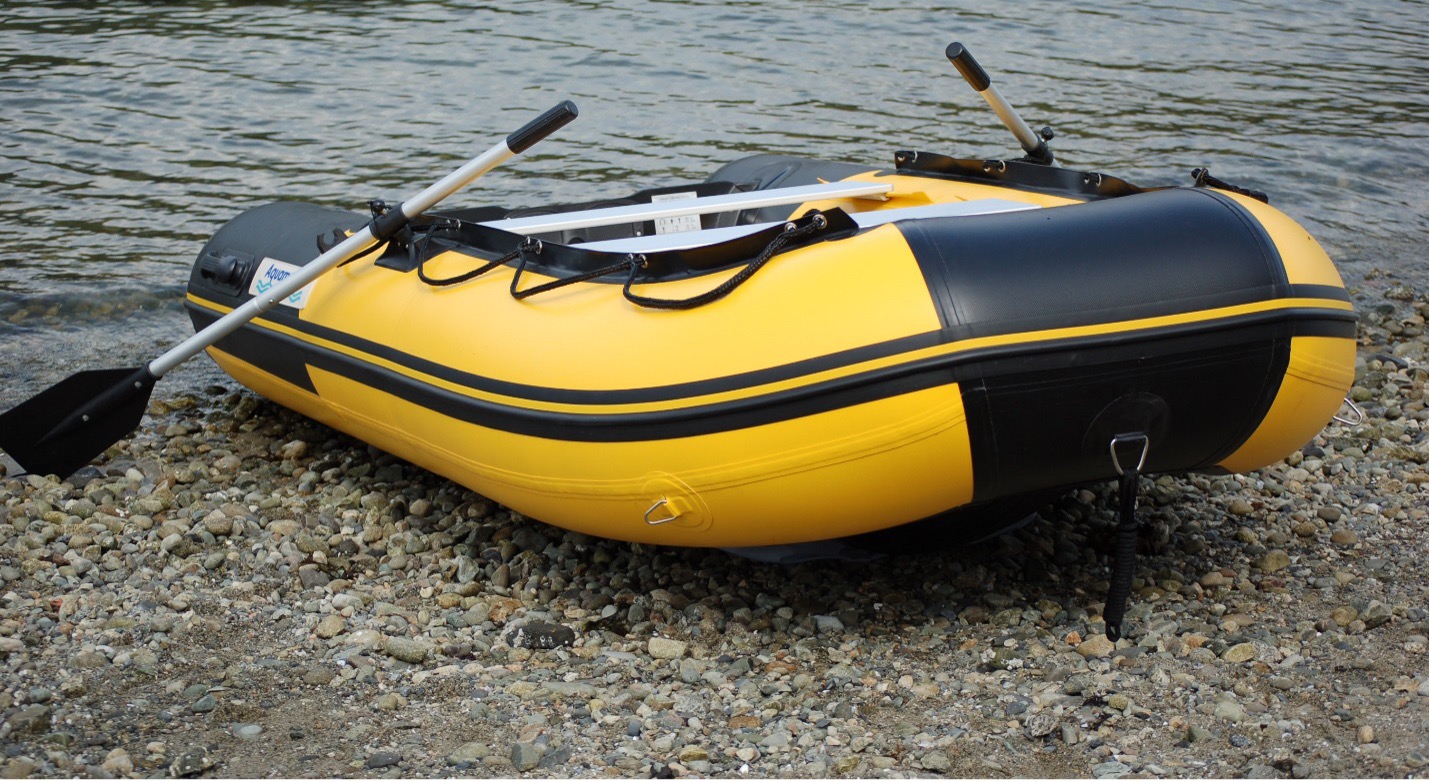
PVC boat maintenance is necessary because no matter how durable the material is, it will quickly lose its original appearance from constant exposure to direct sunlight. First of all, the material itself will burn out - at the first stage only the coloring pigment will fade, but then the polymer composition of the material will also begin to change. “So what, the dinghy is not meant to be admired” - the careless owner of a small boat will say. There is some truth in this. A boat like this is often a workhorse. But the real owner will take care of his horse so that it serves faithfully for a long time. In addition, most anglers prefer to be clean and beautiful.
The service life of the boat directly depends on the habits of the owner. If you scatter knives and sharp-edged equipment on the unprotected bottom, put hooks on inflatable sides, drop them on the floor and then do not clean the boat after fishing, hunting or diving, your floating craft will not last long.
Storing a PVC boat in the winter is a topic of special discussion. We will return to that. But both in summer and in winter, a number of other factors have a critical effect on the material of the boat.
Some scratches without the necessary treatment turn over time into real wounds on the body of the boat. Don’t forget about oil stains and the destructive solvents that are used to destroy these stains. In addition, the incorrectly selected detergent, which is incompatible with the composition of the material, can have a critical effect.
The harmful effects of high temperatures, which most often occur in hot summers, can kill a boat also at other times of the year if you forget how to properly store a PVC boat in winter by rolling it up to a central heating radiator. At the other extreme, you can have a problem storing a PVC boat in a garage where there is no heating, especially in regions with low average winter temperatures. Although PVC boats are more resistant to low temperatures than rubber boats, freezing and then quickly warming the vessel can cause cracks on the sides and bottom.
PVC boats have enemies not only among the forces of nature, but also among the inhabitants of nature. These are various rodents, among which mice are the most harmful, because they gnaw on completely inedible things . Unlike rats, which can only harm a rubber boat sprinkled with starch for “better storage”.
There is no point in discussing how and where it is better to store a PVC boat if you do not have the habit of washing it thoroughly after fishing or hunting. Even if you put the equipment in boxes and make sure that the hooks do not fall on the inflatable parts, there is an insidious enemy of the integrity of your boat - the sand, whether it’s sea or river sand. It gets into the boat by fishermen who prefer to fish in the shallows or those who like to hunt in reed thickets. Sand can also get into the transom dinghy while boating along the shore. Sand is a real abrasive material that is even used to sharpen metal. The destructive effect of sand does not occur immediately, but the process goes on continuously if the boat is not cleaned of sand.
Silt, stuck fish scales, feathers - these are all organic substances that decompose under the influence of sunlight, begin to emit unpleasant odors and, without prolonged cleaning, begin to penetrate into the upper layer of the material. Have you noticed that some boats have an uneven color? It is the result of the owner finally washing off the organic remains - the stains left after organic substances had damaged the boat are still visible.
A PVC boat is harmed by tight rolling during disassembly, especially if during twisting it was not dried and was left in a warm place or in an unheated room in winter. Maybe it won’t get moldy and won’t crack right away, but the creases will remain, and this might cause the destruction of the material. This is true if we are talking about boat care after fishing, hunting or boat trips.
1.2. PVC boat care after each boating trip
You will significantly extend the life of the PVC boat if you take it as an immutable rule after each trip to thoroughly rinse it inside and out with clean water (not sea or river!) using a soft brush, rag or sponge. At the same time, it is imperative to clean the bottom and the inside of the boat from heavy contamination, especially the places between the floor and the sides.
If there is time, then it is better to dry the boat in the air, where there is a lot of free space.
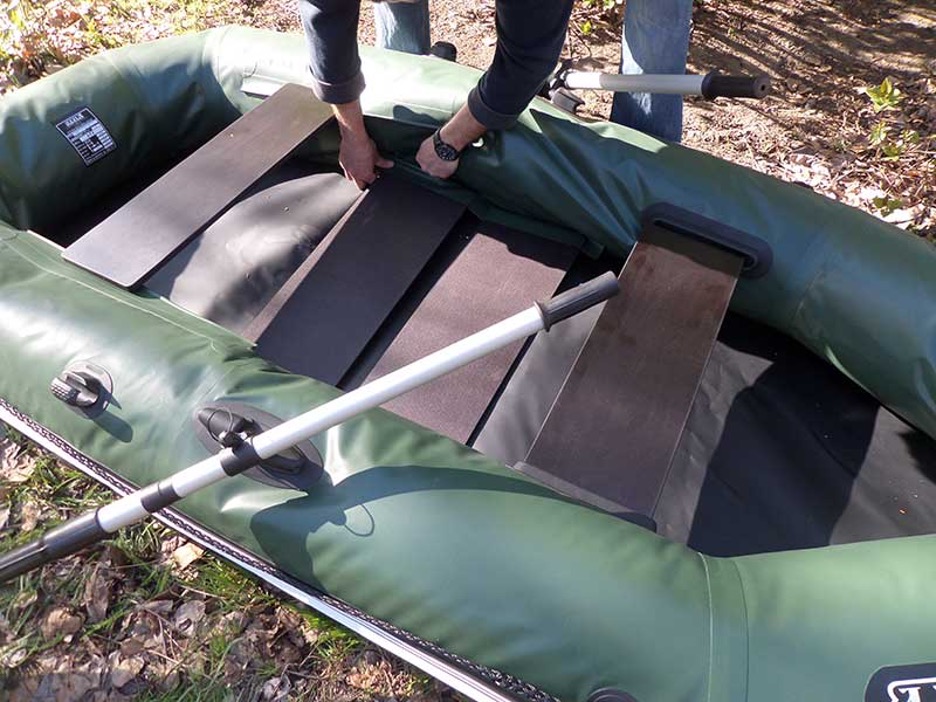
The washed boat is wiped with a clean, dry rag and dried in the shade, and if possible, indoors, half-deflated.
If time does not allow to dry the boat in place, then you will have to do it at home using non-abrasive detergents. Just make sure that small debris do not clog into hard-to-reach places with the pressure of water - this can lead to rotting.
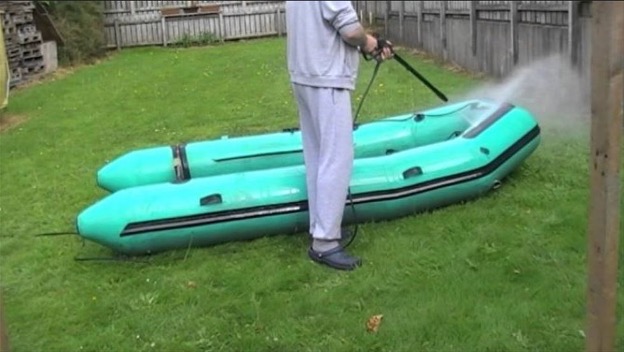
Similarly, the rest of the boat equipment is washed and dried: seats, oars, a pump, plywood or metal flooring.
Boat inspection and repair
As already noted, damage to a PVC dinghy during improper operation does not appear immediately. Therefore, after each trip, the vessel must be carefully examined to identify scuffs, scratches, punctures.
If a puncture could not be avoided, a repair kit will come in handy. Usually it comes with the boat. You can repair a hole or abrasion on the spot. The PVC dinghy can be repaired and then used for, let’s say, fishing on the same day. The damaged area and the patch must be degreased with acetone in advance. The cleaned surfaces are glued together with polyurethane adhesive.
Manufacturers of PVC boats usually attach detailed instructions to the kit and a special repair kit. With this kit, you can repair cuts on a PVC boat or holes. In a situation where a valve or transom is damaged, additional knowledge will also be required. Such repairs are already more serious and require the necessary skills and knowledge. Many PVC boat owners prefer to repair them themselves.
Let's list what damages to the vessel are most often encountered by the owners of PVC boats, and in which cases it is possible to repair the boat on your own.
Puncture - occurs if you accidentally stumble upon a protruding stick, a sharp stone near the shore, pierce the fabric with a hook, knife due to inattention and excitement of fishing or as a result of burning through an unsuccessfully thrown cigarette butt or a spark from a fire. Such damage can be easily repaired on your own on the spot.
Cuts up to 5 cm can also be repaired on your own using a repair kit right on the shore.
To repair punctures and cuts up to 5 centimeters, you need to cut out a patch according to the size of the damage and mark its dimensions on the boat. Depending on the length of the damage, one external patch is made or, for a cut longer than 2 centimeters, two are used: from the inside and outside of the long cut.
When cutting patches, please note that the front side of the PVC is matte, and the opposite side is glossy. The edges should extend beyond the damage by 2 centimeters. Before gluing, degrease the surface, for example, with acetone. If the cut is large and gluing is required from the inside, then it is necessary to apply transverse marks on the front side of the seam to further align the gluing place with them.
Apply the first thin layer of adhesive to the surface you want to patch, as well as to the patch itself. The thinner the application layer, the better. Let the glue dry for 5 minutes, apply a second thin layer of glue. Let the second layer dry - from 5 minutes to 1 hour. Ideally, after this you want to proceed with thermal activation using a building dryer. In this procedure, the main thing is not to overdo it. The heating temperature should be about 160 degrees. When overheated, a glossy sheen appears on polyvinyl chloride, which then does not disappear. Then you roll the glued parts with a metal plate or roller with a pressing force of about 6 kg for 30 seconds.
The boat repair will serve you for many more years after such repair.
More serious cuts and lacerations of more than 5 cm are possible when the boat collides with driftwood, snags, rapids, rocky shallows, and various submerged objects. In shallow water bodies close to the shore, protruding fittings, flooded ships, remains of bridges, crossings, etc. can come across. Repair of such damage is best left to professionals.
You might also encounter some serious damage to boat components. Transom, valve, keel, bottom and more can fail during long-term operation. The reasons for this may be different, such as mechanical impact or poor drying in the case of a transom. In some boats there are frank blunders in the design of parts that are found out only during long-term operation. If you are not confident in your skills, it is better in such cases to contact professional repairmen.
Difficulties in caring for a model with a motor
The motor gearbox usually suffers a lot. During the operation of the motor, it has a large load. During long-term storage, condensation and various deposits may form on the engine. Whereas during operation this usually does not happen. Therefore, do not forget to periodically inspect the engine, especially if it is stored in a cold room.
PVC boat storage
A PVC boat should be specially prepared for storage both during the season of active usage and when preparing it for wintering, if you decide to take a break. There are some tricks here, which are described below.
Boat storage during the active season
The main thing when storing a boat during the season of active operation is to ensure proper care after returning from the water. We already talked about it in section 1.2.
After cleaning, washing and drying, the PVC boat can be carefully rolled up, put in a bag and stored until the next use. Roll up exactly according to the attached instructions. Usually folding is carried out in the direction from the transom to the bow.
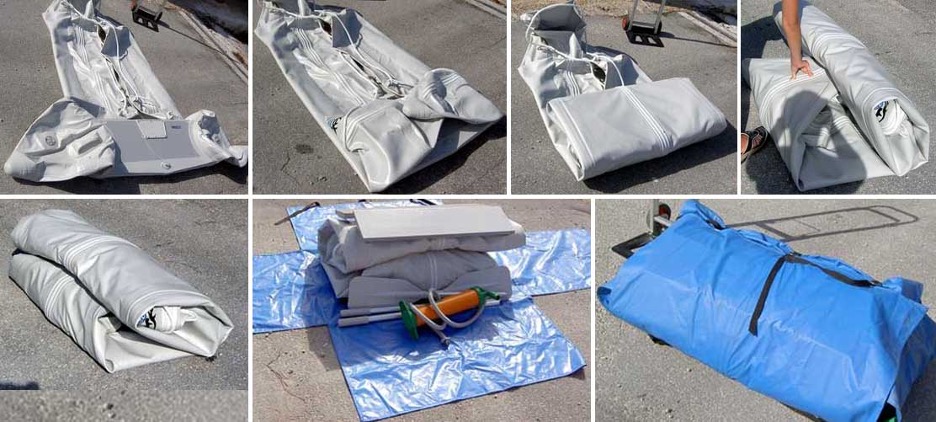
Even better if there is a special room. The boat is stored there on a special rack, stands or against the wall, after releasing a little air from the chambers.
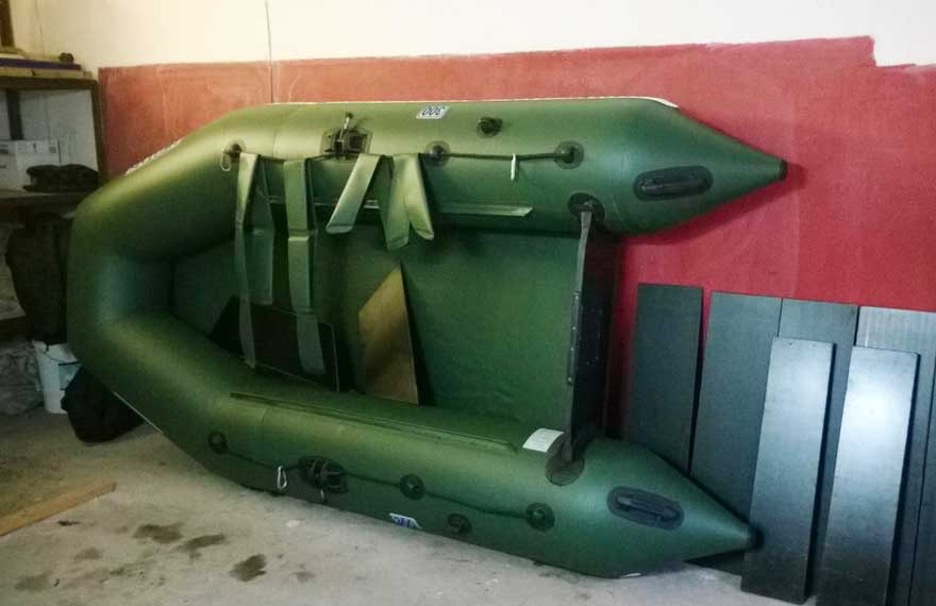
PVC dinghy storage in winter
To prepare a PVC boat for winter storage, it is not enough to thoroughly shake out the debris that may have accumulated in the boat and wash it with fresh, clean water. The vessel, most likely, during the season managed to be saturated with the smells of caught fish, waterfowl, food, etc. This can attract rodents to a shed, garage, or pantry. Therefore, after cleaning the dinghy from dry debris, the vessel should be treated with soapy water inside and out.
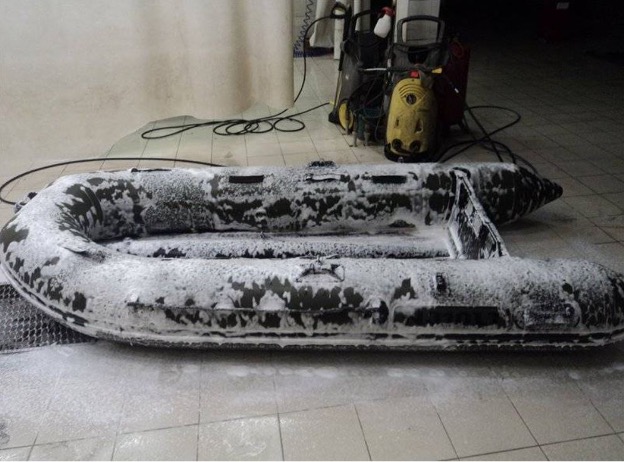
Particular attention should be paid to:
- places where bottom and sides connect;
- fixings for flooring;
- side surfaces.
As a rule, the instructions contain recommendations on which detergent is best suited to the material of the boat. We advise you to follow them, as some compositions for the popular inflatable boat care products contain ingredients that can be harmful to PVC fabric.
ATTENTION! Never use hard brushes or abrasive cleaners to clean or wash the boat.
After washing with detergent, rinse the boat well with a jet of water or remove any residue with a damp cloth.

Dry the boat outdoors. If you did not have time to send it to winter storage before the first frosts, you should limit yourself to dry cleaning, because if you try to dry the material at sub-zero temperatures, there is a risk of an ice crust and creases on PVC material.
You can dry the washed boat in a heated, but not too heated room away from heating appliances.
Storage in inflated state
It is optimal to send an inflatable boat to winter in a covered area, after slightly lowering the cylinders. It would be best to fix the structure under the ceiling, this will provide additional protection against the attack of rats and mice. Can be covered with an awning.
Storage in deflated state
If you do not have enough space, deflate the vessel, lay it out on a clean, flat surface, roll it up (with the air valves open) and pack it in a special bag - as a rule, such an accessory comes with the basic kit.
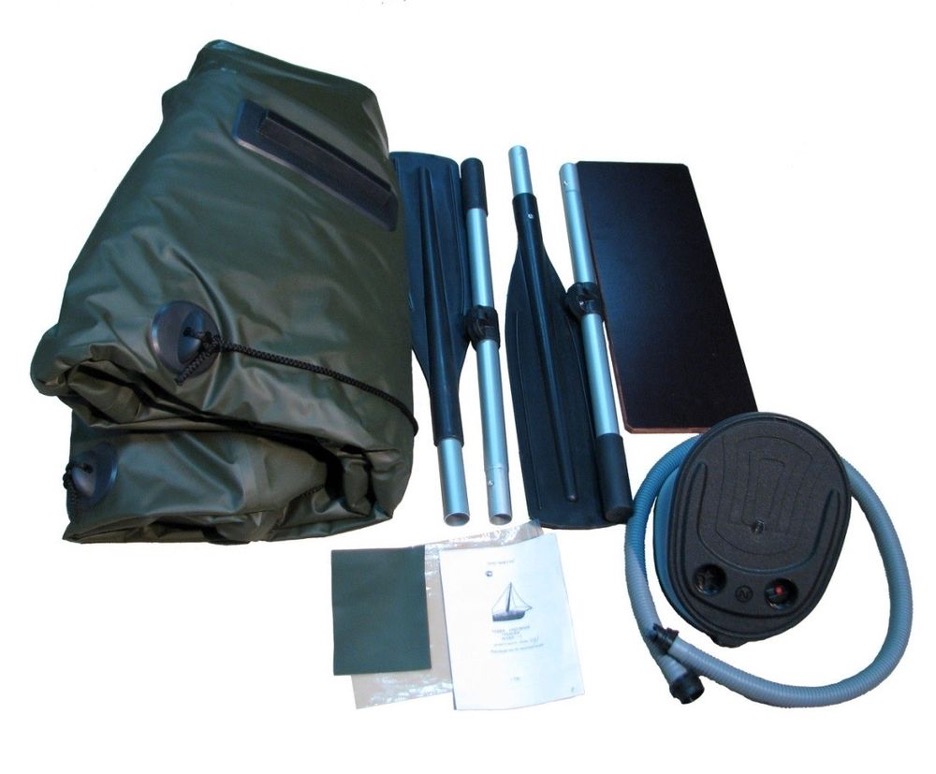
It will be better and safer for the dinghy (to avoid deformation of the material) if it is rolled up in a way it comes from the factory. How to do this is described in the instructions for the boat. If the documents are lost, you can search for the necessary information on the internet, contact the manufacturer or its representative.
To properly put the boat in the bag, you must perform a series of sequential steps:
- release air from the chambers through open valves;
- remove seats, stringers and flooring from the boat;
- press the ends of the side chambers to the transom;
- fold the sides inside the boat;
- turn the boat starting from transom in the direction of the bow.
The oars are packed in a bag with the boat, and the seats and hard flooring are placed in a separate bag.
If possible, the boat should be suspended in a semi-inflated state in a barn or garage using hoists and blocks. The easiest way to hang it is to attach the boat to the hooks on the ceiling.
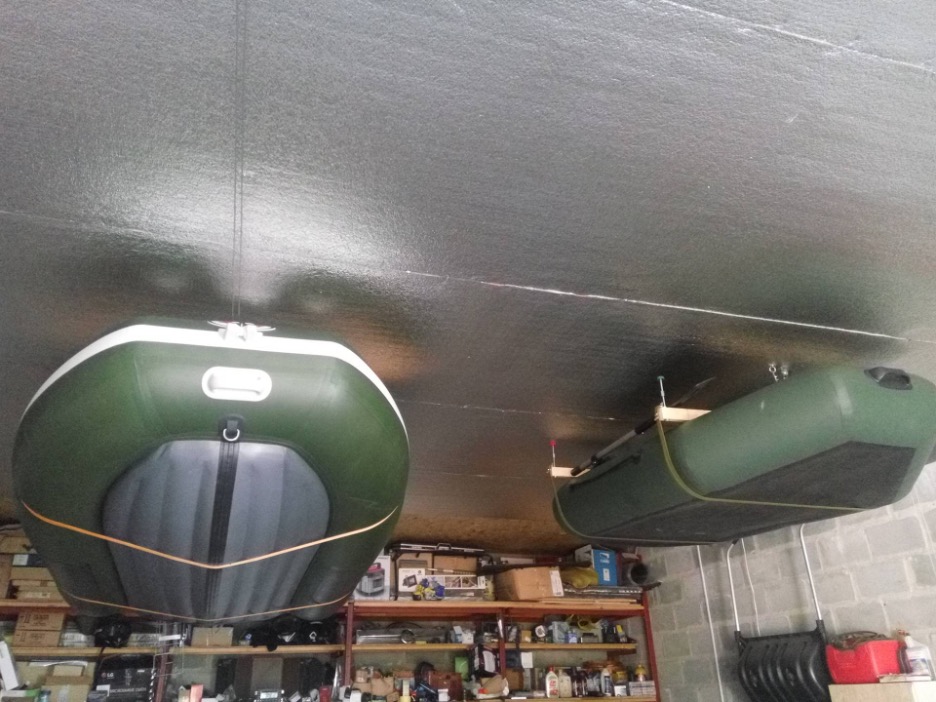
In the places of storage with sub-zero temperatures, it is not recommended to move the bag with the boat from a cold shed to a warm house, and vice versa. This contributes to the formation of condensation and the development of mold and mildew.
In the spring, the bag with the boat is taken out, warmed up for several hours, the boat is removed, visually checked for mechanical damage, inflated and checked for leaks. If the side cylinders hold air pressure for several hours, the boat is ready for usage.
Any storage option must be protected from rodents. The boat can be treated with special products that can scare away uninvited guests.
Water must not be allowed to come into contact with the surface of the material. You should choose a non-flooded room with a normal level of humidity for storage. Otherwise, the accumulated moisture will turn into ice and will destroy the PVC if the room is not heated. And in a warm room, this can lead to the development of fungus and mold.
How to wash the boat and what to use to do it
Let us quote the operating instructions for PVC boats from one well-known and popular manufacturer: “At the end of the voyage, wash the boat and accessories with the recommended product or neutral soap and rinse with fresh water. To wash the boat and its components, do not use cleaning products containing alcohols, alkalis, solvents and abrasive materials”.
Of course, the boat can be perfectly washed with any cleaning agent so that it will be cleaner and better than new. Moreover, the deplorable results of such “care” cannot be immediately determined by eye - PVC is a very durable material. But in a year or two, microscopic defects will turn into noticeable damage.
While soap suds can be used to wash a boat made of rubberized fabric, for most boats made of PVC and other similar materials, manufacturers recommend narrow-profile detergents that may contain various beneficial additives, such as UV protection.
Some products provide PVC fabric with the effect of repelling water, oil, dust, protection against the formation of ice crust, mold, etc.
The main thing is to carefully read the composition of the cleaning product and the area of its use.
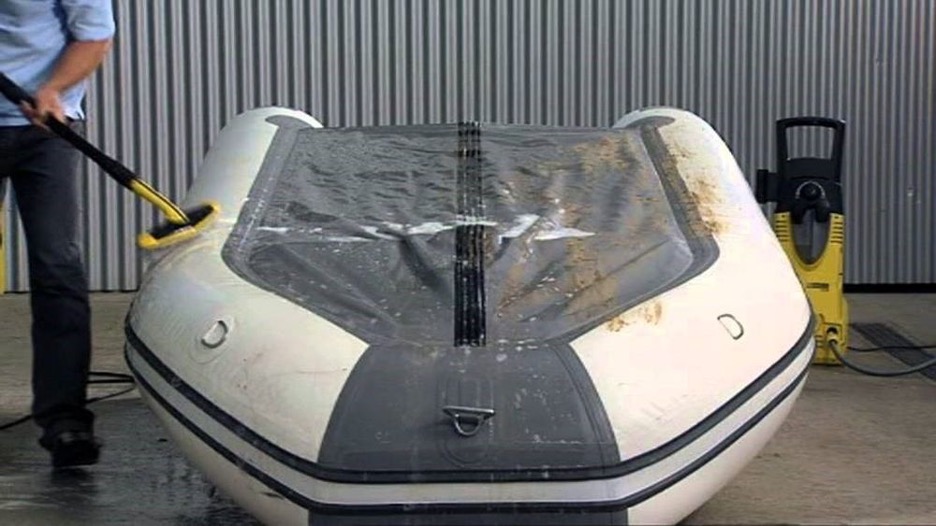
In no case should you use conventional cleaning products for removing stains, treating mold or fungus. Means against rodents should also not be poured onto the surface of the boat, but should be used around the surrounding area.
Summary tips for operating an inflatable PVC boat
Experience shows that the service life of a PVC inflatable boat largely depends not on its cost, but on its proper usage. Extend the life of your boat with our PVC boat care tips.
- Regular cleaning - after swimming, clean the surface of the boat from fish oil, grains of sand and algae. Adhering particles and aggressive chemicals contribute to tissue destruction. Thoroughly clean the seams, which are often clogged with debris.
- It is necessary to clean not only the boat, but also the components - the pump, oars and other elements also need care.
- Drying - do not leave a wet boat in the garage. It can become moldy, and in cold weather ice crust might appear. As a result, the material will begin to break down.
- In order for the surface to dry faster, the boat should be laid on its side. If desired, you can wipe it with a cloth.
- Washing with soap - never scrub the boat with steel wool or abrasive detergents. Before long-term storage, clean the watercraft with a soft sponge dampened with soapy water.
- Careful handling - use boxes for fishing accessories. Do not put knives and hooks on the bottom, to avoid PVC material tearing.
- Inspect the shore - before launching, remove sharp snags and stones from the way.
- Keep the boat away from fire - the heat from a fire or a lit cigarette can melt the material. Do not smoke near the boat. Burning the material is much easier than restoring it.
- Carefully fold the boat - store the product folded. Make sure that when folding, twigs, sand and earth particles do not fall inside.
- Dry the inflated boat - it will be better to drain the water beforehand.
- Roll the boat with the valves open from stern to bow. If you have a model with a motor, the ends of the side cylinders must be pressed against the transom.
- Do not load the boat with heavy objects during transportation or storage - such actions quite often lead to damage.
- Do not leave the product under the scorching sun - it is especially dangerous to leave inflated boats in the heat. Look for a spot in the shade of trees or a covered shed.
- Store your dinghy in a safe place - new boats often are damaged by rodents. You can protect yourself from uninvited guests by washing the fabric well. Then there will be no smell of fish, which mice like so much.
- Create optimal storage conditions - the room temperature should be maintained between 0 and 25 degrees Celsius. If you have left the boat in sub-zero temperatures, let it warm up before use.
- Discard talc - it is suitable for rubber products. PVC will be difficult to clean, making repairs difficult later.
- Do not try to do the tuning hastily with improvised means - if the boat does not have seats, do not put boards or logs instead. They will damage fragile material.
- Carefully read the instructions, always follow the manufacturer's recommendations.
- At low temperatures, it is better not to unroll or move a rolled boat, as unwanted cracks may form on the fabric.
- If the boat is suspended from the ceiling, it does not experience large fluctuations in humidity. In addition, rodents will not be able to get to it and make a nest for themselves.
Failure to follow the rules of care reduces the life of the boat by 2-3 times. A properly maintained boat will serve you for many years. If you store it in a dry garage free from rodents and corrosive substances, it will last until next season without damage.
The material of such boats is a dense fabric covered with high-quality polyvinyl chloride. Moreover, there are several layers of such coatings. A PVC boat can overcome many water obstacles and last a long time with careful handling and regular maintenance.




